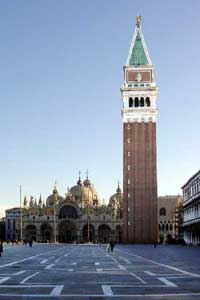|
In 1723 the bricks were replaced with a more complex geometrical pavement design composed of a field of dark-colored igneous trachyte with geometrical designs executed in white Istrian stone.
Squares of diagonally-laid blocks alternated with rectangular and oval designs along broad parallel bands. The squares were pitched to the center, like a bowl, where a drain conducted surface water into a below-grade drainage system.
The pattern connected the central portal of the Basilica with the center of the western opening into the piazza. The design was laid out by Venetian architect Andrea Tirali.
In 1890, the pavement was renewed due to wear and tear. The new work closely follows Tirali's design, but eliminated the oval shapes and cut off the west edge of the pattern to accommodate the Napoleanic wing at that end of the Piazza.
On both sides of the piazza are the Procuratie buildings, which housed the procurators of San Marco.
The buildings around the Piazza, anti-clockwise from the Grand Canal, are the Doge's Palace, St Mark's Basilica, St Mark's Clocktower, the Procuratie Vecchie, the Napoleonic Wing of the Procuraties, the Procuratie Nuove, St Mark's Campanile and Logetta and the Biblioteca Marciana.
|
 |